2021 Governor's Award for Environmental Excellence
DEP honored 13 projects by schools, businesses, and community organizations around the state with the 2021 Governor’s Awards for Environmental Excellence.
Collectively, the award-winning projects engaged hundreds of partners and resulted in:
- Creation of 8.5 acres of wetlands and 5 acres of tree or other vegetation buffers on stream banks to remove over 675 tons of sediment, 6,000 pounds of nitrogen, and 375 pounds of phosphorous annually from waterways;
- Planting of more than 3,200 native trees and shrubs that will sequester over 400,000 pounds of carbon from the air and remove more than 2,600 pounds of other air pollutants over 25 years;
- Remediation of 300,000 square feet of hazardous materials and sustainable redevelopment of nearly 200 acres of former industrial property;
- Education of more than 1,100 Pennsylvania students and nearly 24,000 residents on environmental issues;
- Over 100 new or updated Agricultural Erosion and Sediment Management Plans or Manure Management Plans;
- Installation of three air quality monitors for local communities; and
- Generation of over 2.7 million kilowatt hours of electricity from solar energy.
The 2021 Governor’s Awards for Environmental Excellence were awarded to:
RIDC Mill 19 at Hazelwood Green
Regional Industrial Development Corporation
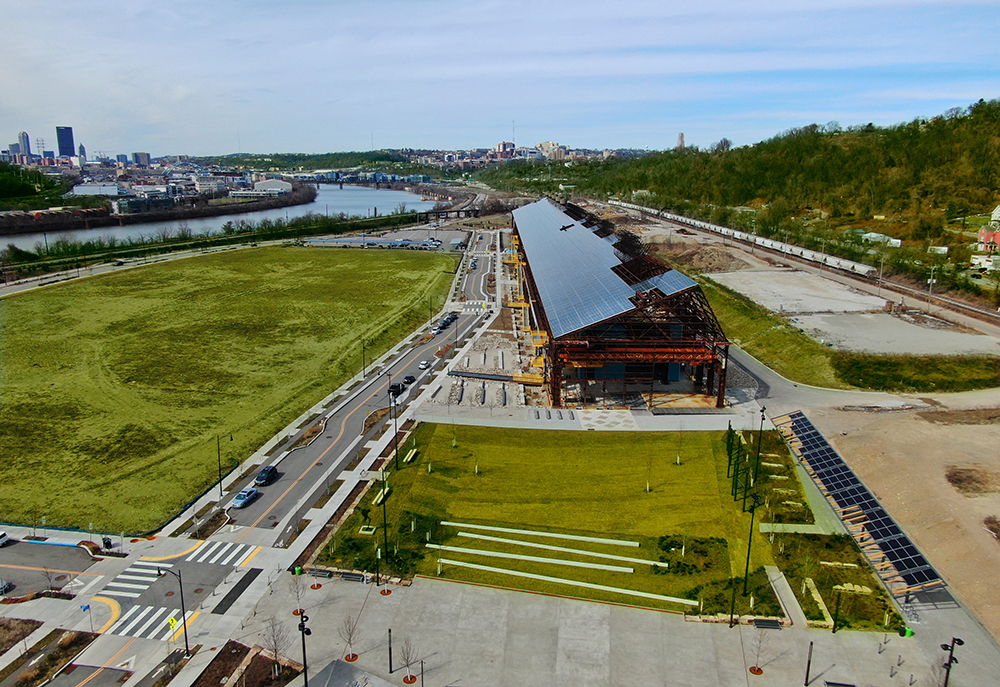
The Mill 19 project converted a former industrial mill into a new high-tech facility striving for LEED v4 Platinum certification. RIDC Mill 19, a former steel mill located on the 178-acre Hazelwood Green site is the last large riverfront brownfield within Pittsburgh city limits. With the revival, reuse and occupancy of one of its three buildings, RIDC Mill 19’s design features a building within a building concept to showcase the community’s past, present and promising future. The mill’s metal walls, and roof have been stripped away to reveal its underlaying steel superstructure while maximizing energy efficiency and building material reuse. RIDC also abated large quantities of galbestos and lead during this process, preventing further contamination of the surrounding environment. One of the largest rooftop solar arrays in the country recently went live on top of RIDC’s Mill 19 superstructure. 110,000 square feet of high-powered solar panels cover the entire rooftop area and will produce over two million kilowatt hours (kWh) per year, enough to power the entire existing facility.
Northern Forest Restoration at Pennypack on the Delaware
Riverfront North Partnership
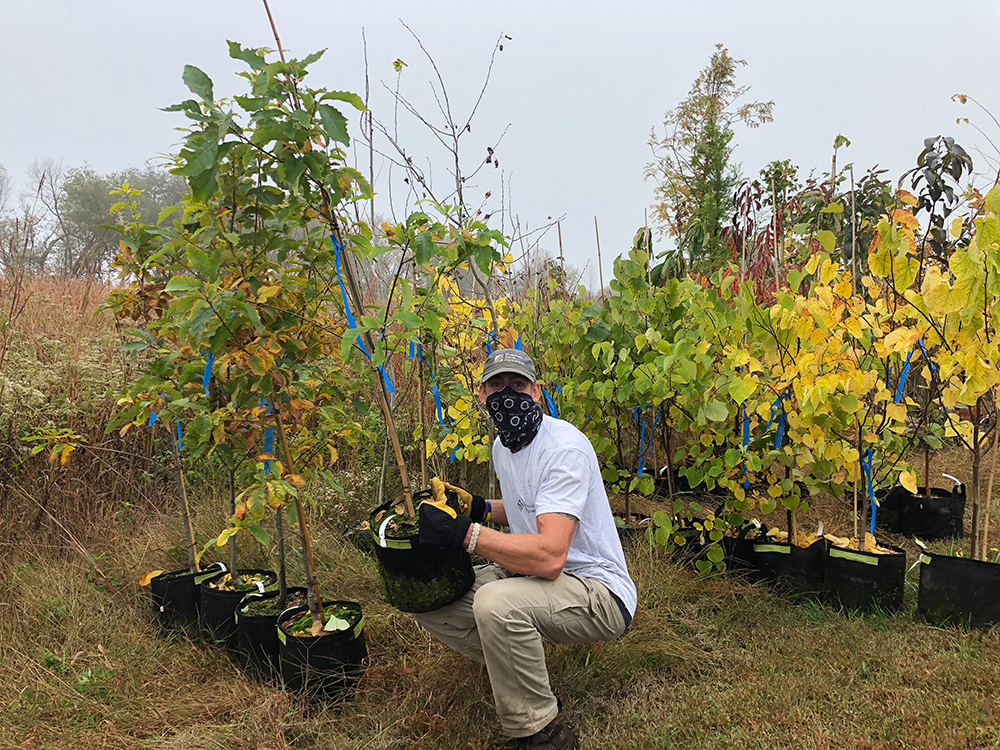
The Northern Forest Restoration is a multi-year riparian forest buffer installation effort on a decommissioned garbage dump adjoining the tidal confluence the Pennypack Creek and Delaware River next to the source of Philadelphia’s drinking water. The 2020 project objective focused on engaging workforce development partners and providing opportunities for the community to have safe, social, but socially distant, outdoor volunteer opportunities continuing a riparian buffer restoration. RNP offered training on proper tree planting as work began and provided trees and assistance to partner groups. The work expanded to include Fluehr Park. It also included distribution of native fruit bearing trees to the Philadelphia Prison System, adjacent to the park, which operates an orchard that provides job skill training to incarcerated individuals.
The Plain Sect Community and Market Engagement for Clean Water
Lancaster Farmland Trust
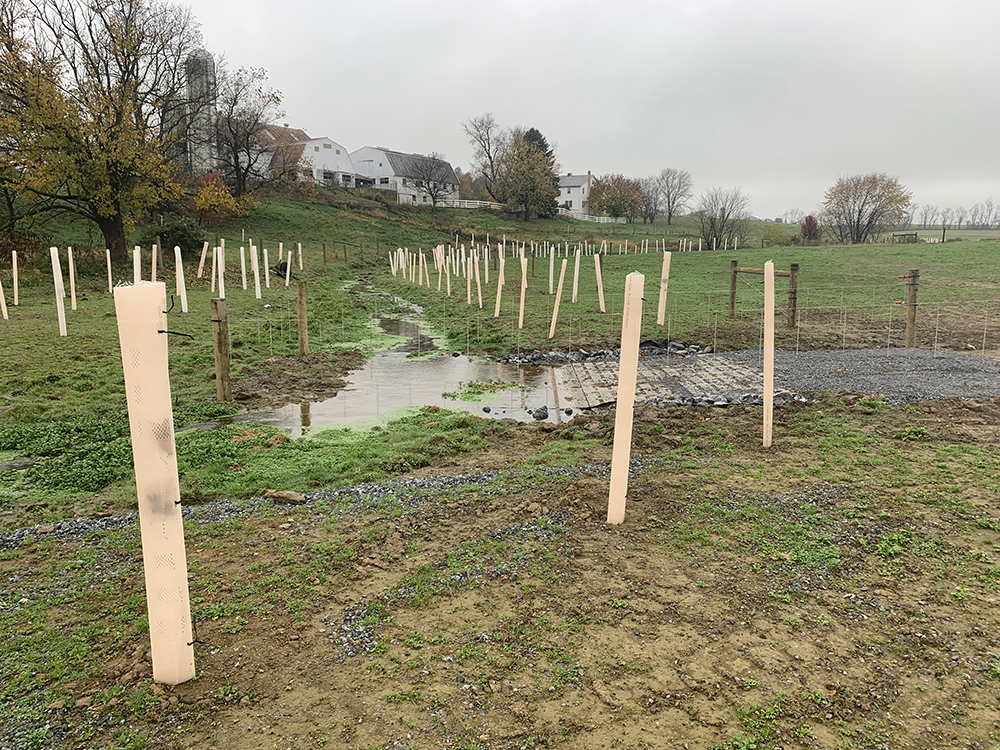
The objective of the project is to reduce nitrogen, phosphorus, and sediment pollution flowing from farms in Salisbury Township to the Chesapeake Bay. The outcomes of the project were:
- Develop network of model farms and create “Learning Farms” to demonstrate farm sustainability and provide real-life examples: Four learning farms, and 112 new erosion and sediment and/or manure management plans have been developed to date.
- Elevate community value of conservation using data to inform decision making: Used analysis to determine which practices provided cost-savings to farm operations to encourage adoption. LFT developed a watershed mapping tool to prioritize farms and BMP installation.
- Build the capacity of trusted local farm advisors: LFT conducted outreach to private sector entities who interact regularly with farmers to solicit engagement in the project, and hosted workshops on water quality topics and introduce the Sustainability Programming online training.
- Engage the marketplace: The team connected with dairy cooperatives to enlist their support in incentivizing sustainable practices, and recruited supply chain members to act as REAP sponsors to infuse additional funding into the project.
Urban Sustainability
Commonwealth Charter Academy
This project teaches sustainable techniques to K-12 students and all residents of the Commonwealth. CCA installed a 6,100-sqft Aquaponics/Hydroponics lab that includes about 400 fish and 3,000 plants in a controlled growing environment. All organically grown produce, by students, is donated to local food banks. To provide power for the AgWorks system, CCA installed 1080 solar panels that generates .5MW of electricity. This solar array provides a third of the necessary power for the facility and 100% of the power to run the AgWorks lab. This program is open to all age groups and the public.
Site Improvement
York County Solid Waste and Refuse Authority
The project focused on enhancements to the York County Resource Recovery Center (RRC) and the construction of an Ash Processing and Recycling facility that uses first of its kind technology to separate metals, aggregates and sand from the combustion ash, reducing the amount of ash that must be managed in a landfill by between 60-80% depending on available end-user markets. Improvements at the RRC included yard waste collection and free residential electronics recycling. Sustainability aspects of this project included a vault system to capture surface water runoff of up to 500,000 gallons that is then reused to quench hot combustion ash and for other facility uses. In addition, a surge tank that can hold up to 18,000 gallons was installed to collect water runoff from three acres of roof space and that water is used to supplement cooling tower water. All new structures feature LED lighting to conserve power and cooling tower steam is used for radiant heat to melt snow at the education center parking lot and sidewalks. Improvements were also made to the now-closed York County Sanitary Landfill which has been “recycled” into a 208-acre wildlife habitat featuring two wildlife viewing platforms and mowed walking trails An 806-panel solar array has also been installed and provides 300,000 kilowatt hours (AC) of electricity annually which is approximately half the annual energy usage at the landfill.
Wildlife on WiFi
Pennsylvania Game Commission
This project launched in April 2020 shortly after initial COVID-19 orders went into effect and in line with National Environmental Education Week, Wildlife on WiFi (WoW) is the Pennsylvania Game Commission’s new nationally recognized remote and virtual conservation learning program. The original objective of the program was to ensure the agency continued meeting its strategic objective of serving the Pennsylvania public and providing educational services during the COVID-19 pandemic but has been so successful that it is now a permanent program. WoW provides educators, students, parents, and high-risk health communities, as well as general audiences, with home-based conservation and wildlife science education using an online hub for lessons and activities, live virtual sessions, field researcher webinars, and social media games.
Breathe Easy: Triborough EcoDistrict Air Quality Project
EvolveEA & New Sun Rising
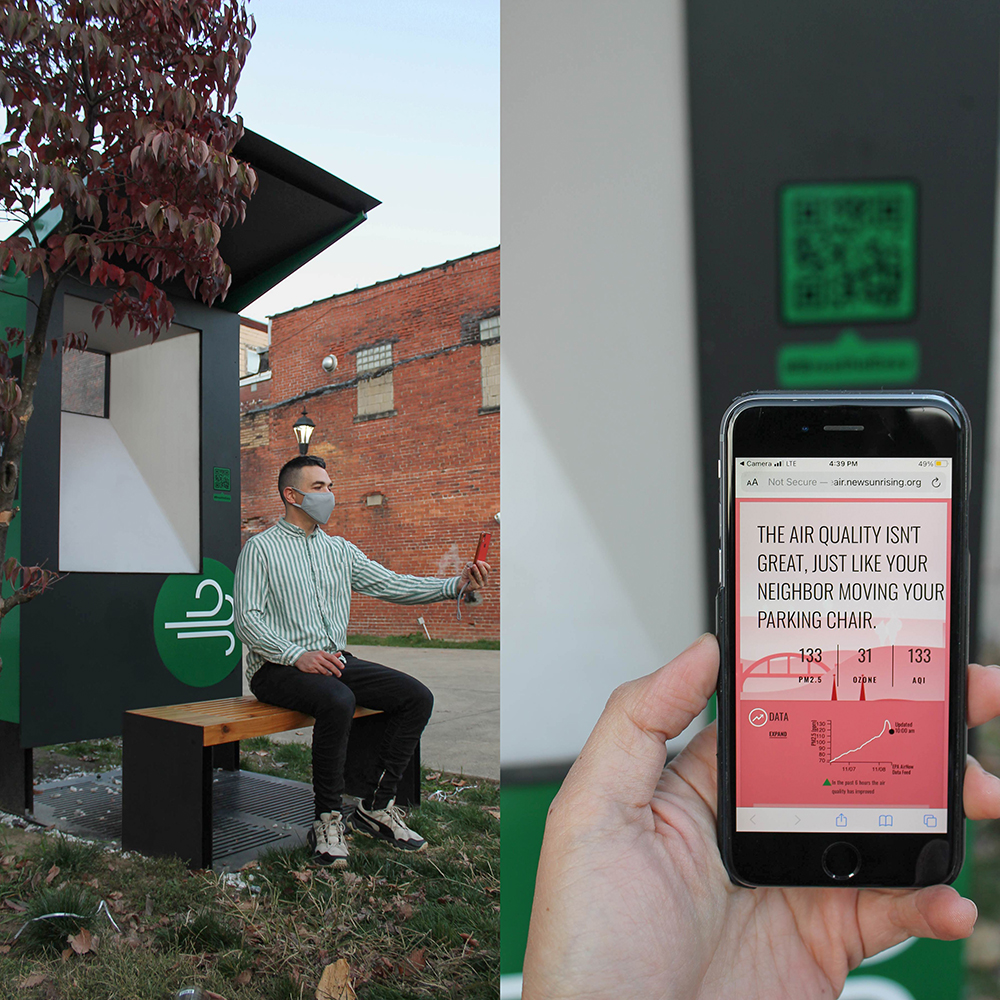
Breathe Easy is an initiative launched first by the Millvale EcoDistrict with a community plan intended to build capacity in the region to understand the science of air quality and address Southwestern Pennsylvania’s poor outdoor air quality. As the Breathe Easy Millvale Air Quality Plan was completed in 2016, the Triboro EcoDistrict was formed as a collaboration between Millvale and neighboring boroughs Sharpsburg and Etna. Implementation projects from the plan have been carried out with strong community support, giving the public access to air quality data and tools to take action. Monitoring devices were installed in several locations, and a program in Millvale also helps residents monitor and improve their indoor air quality. An online dashboard was created to display real-time outdoor air quality data, and most recently Etna, Millvale, and Sharpsburg each installed a uniquely designed monitoring station that doubles as a public space and social media selfie spot to help promote a regional Breathe Easy campaign. The planning process and implementation projects have activated many residents across the Triboro EcoDistrict, and their impact continues to grow.
Muddy Creek Stream Restoration-Marquardt Farm, Phase 3
Penns Valley Conservation Association
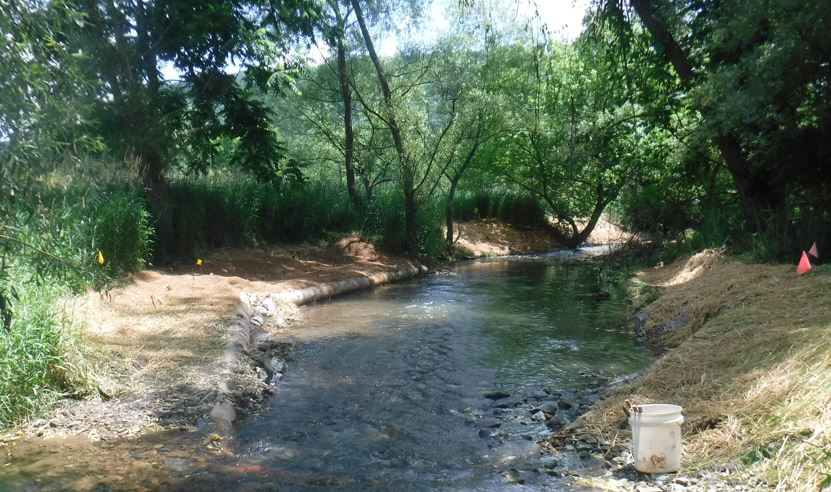
Five farmers own the two-mile section of Muddy Creek where Phase One and Phase Two of the restoration project was completed. Restoration of a 1,200 ft reach of stream on the Marquardt farm comprises Phase Three, the final phase of the work on this stream reach. To address the erosion component of impairment to this stream segment, PVCA in conjunction with its partners, installed 16 bank stabilization and fish habit structures. Increased spawning substrates resulted from the placement of along vane structures. Elevated summer water temperatures and large variations in stream temperature due to a lack of riparian buffers were addressed by restoration of the riparian buffer along the stream reach on the Marquardt farm. High density plantings of native tree and shrub species provide shade for the stream and stabilize seasonal water temperature fluctuations. Additionally, restored riparian buffers help to stabilize stream banks to minimize soil erosion and provide additional wildlife habitat.
Lime Spring Square
RGS Associates and Land Studies
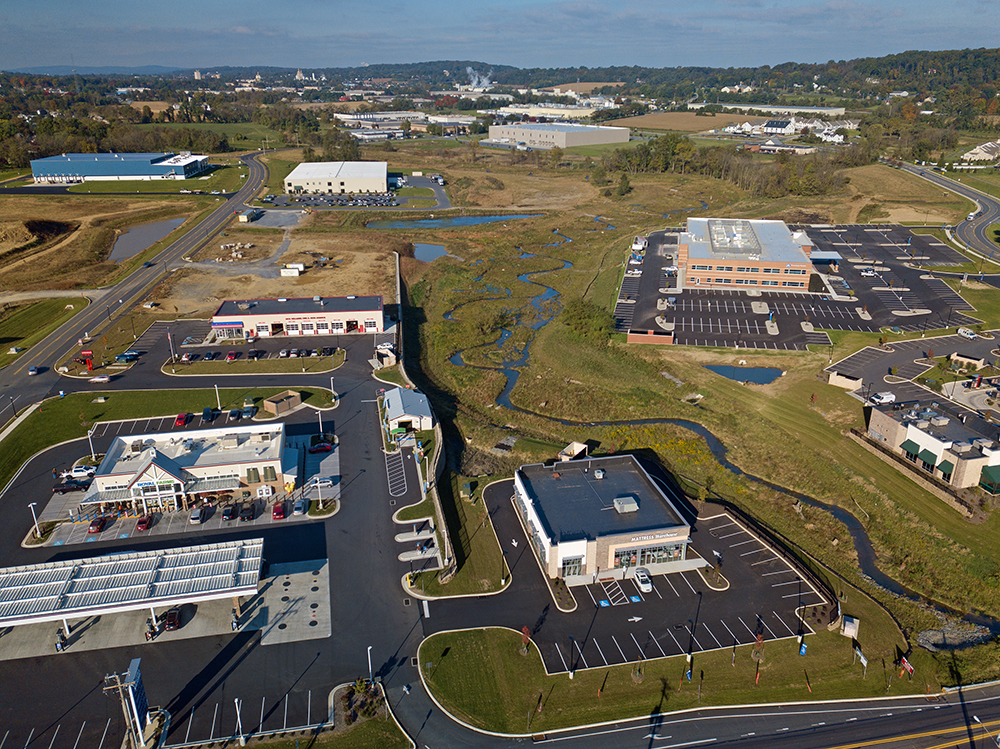
Lime Spring Square is a 98-acre, multi-phased, mixed use development. Offering a unique approach to post construction stormwater management, a floodplain restoration was implemented as the primary BMP (in lieu of conventional infiltration or detention facilities) to meet the regulatory requirements. This approach includes the removal of sediment to reconnect the stream channel with the floodplain, the creation of large areas of interconnected wetland habitats, and the rehabilitation of groundwater interchange. In total, this project restored 4750 linear feet of stream bank and created 8.5 acres of wetlands, reducing runoff to the Chesapeake Bay Watershed.
Wissahickon Headwaters Stream and Riparian Restoration Project
Wissahickon Trails, PECO, Upper Gwynedd Township, William Penn Foundation, Merck, National Fish and Wildlife Foundation
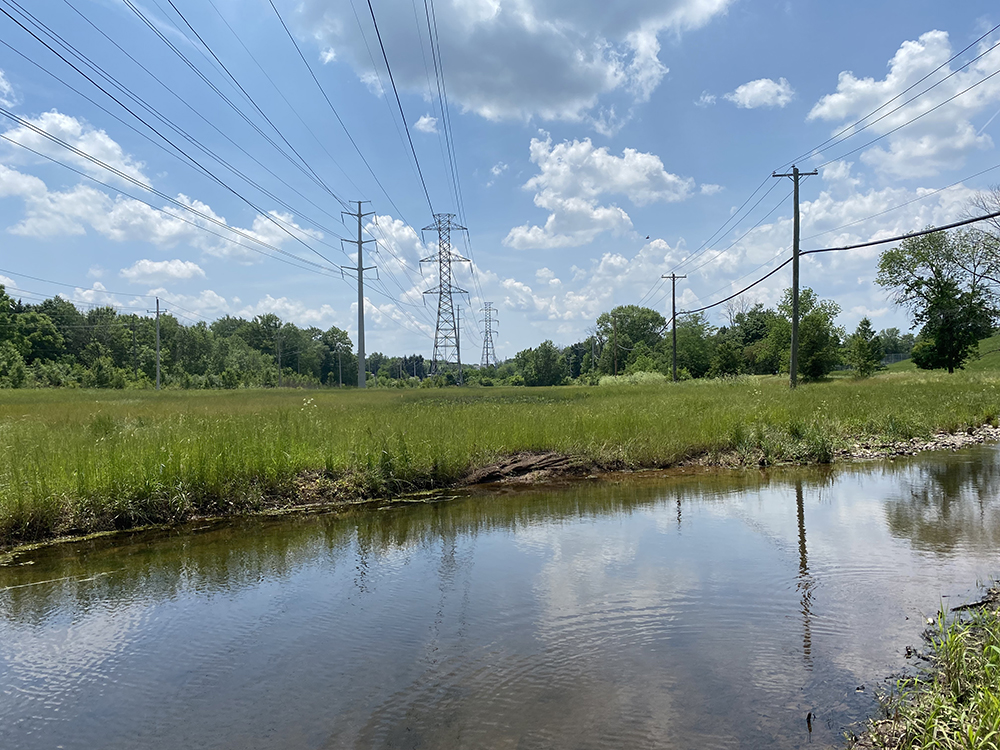
The Wissahickon Headwaters Stream and Riparian Restoration includes restoring and stabilizing the stream channel and reconnecting the floodplain along 1,775 linear feet of the Wissahickon Creek in the PECO Right of Way power line corridor. Before restoration, flow of the Wissahickon Creek was fully contained within the existing eroded stream banks, leading to higher water depths during storm events (5ft-10ft eroded banks). The floodplain reconnection approach will address all of the stream functions that were compromised due to unnatural stormwater conditions. Based on expert panel estimates, the proposed stream restoration of 1,775 linear feet will result in load reductions of 275 tons of suspended solids, 355 pounds of nitrogen, and 121 pounds of phosphorous. Reducing nutrient and sediment loads into the Creek will reduce algae blooms, increase dissolved oxygen concentrations, and improve the habitat for aquatic organisms including macroinvertebrates. This project will also improve habitat in the creek, wetland, and floodplain, riparian buffer, and improve the Wissahickon Watershed as a whole by increasing stormwater infiltration during storm events in the headwaters.
Multi-Environmental Parameters Dashboard for Susquehanna River Basin
Harrisburg University of Science and Technology
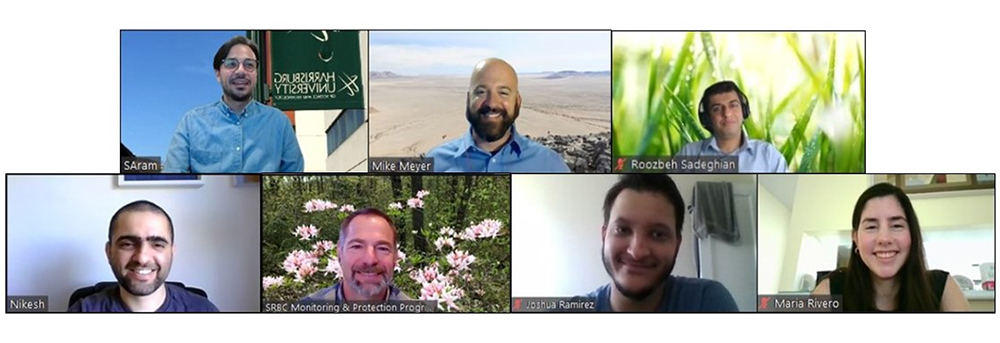
This collaboration introduces data analytics tools into SRBC's daily monitoring and controlling activities to provide insights and understand real-time data collected from their satellite stations, providing more accurate and timely results and enabling more efficient, effective, and pragmatic decision-making. The team built an initial Machine Learning (ML) model to predict the river flow of the Pine Creek Watershed of the Susquehanna River Basin. They then developed an operational dashboard using ARCGISPro, featuring a map element that includes a layer of precipitation, sub-basin boundaries, water trails, the soils, and bedrock geology Pine Creek watershed of the Susquehanna River Basin. They then furthered the initial Machine Learning model, including five environmental parameters to predict the specific conductance of water of the Pine Creek Watershed of the Susquehanna River Basin. The parameters identified were temperature, turbidity, pH, dissolved oxygen, and specific conductance. Innovated the existing operational dashboard embedding the resulting and advanced Machine Learning model, selecting a seven-day prediction of water's specific conductance.
Sechler Run Stream Restoration Project
Geisinger
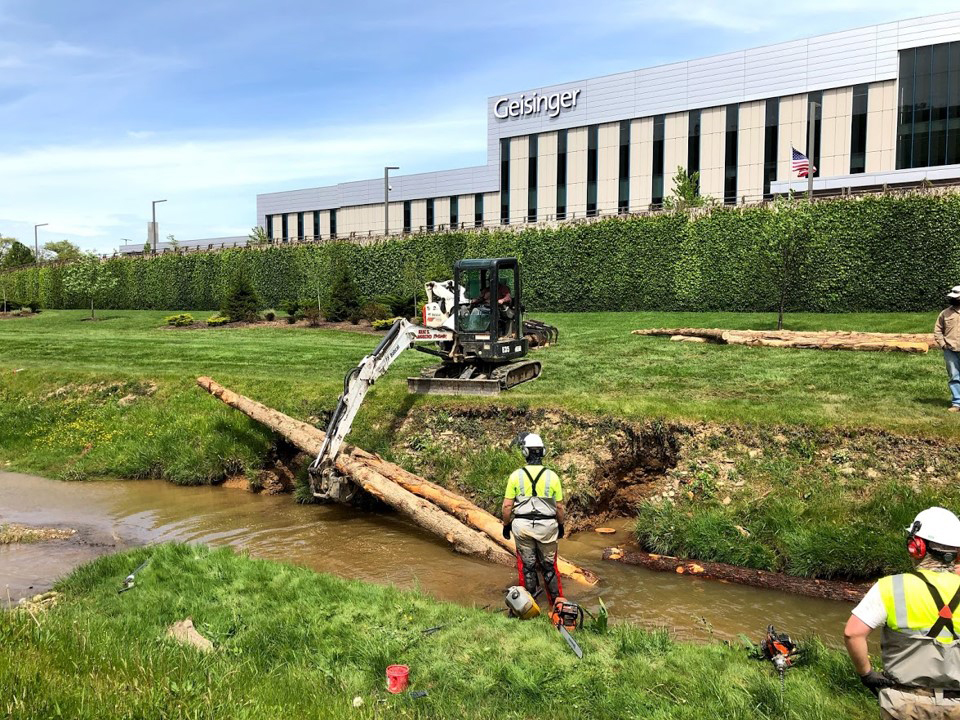
Sechler Run is an agriculturally impaired stream that runs along the front of Geisinger Outpatient Surgery Woodbine (OSW). Geisinger was approached by a team of community stakeholders about considering a project to improve the stream’s water. Representatives from environmental groups met with Geisinger and explained the steep, eroding streambanks were adding sediment to the stream system, and coating the streambed. The stream had incised over the years and its inability to spready out and slowdown during high water events was adding to the problem. Working with these partners 1,100 feet of Sechler Run, an Agriculturally impaired stream in the Chesapeake Bay watershed, was stabilized using log and rock structures. Floodplain benches were improved, and the streambanks were graded to allow better access to the floodplain. A 2-acre riparian buffer of shrubs and trees were planted and, a five-foot-wide quarter mile long, walking path was built to allow staff and visitors to walk along the stream. They also planted a 1,000-foot-long wildflower buffer for pollinators.
Protect Our Lake
North East Intermediate Elementary School
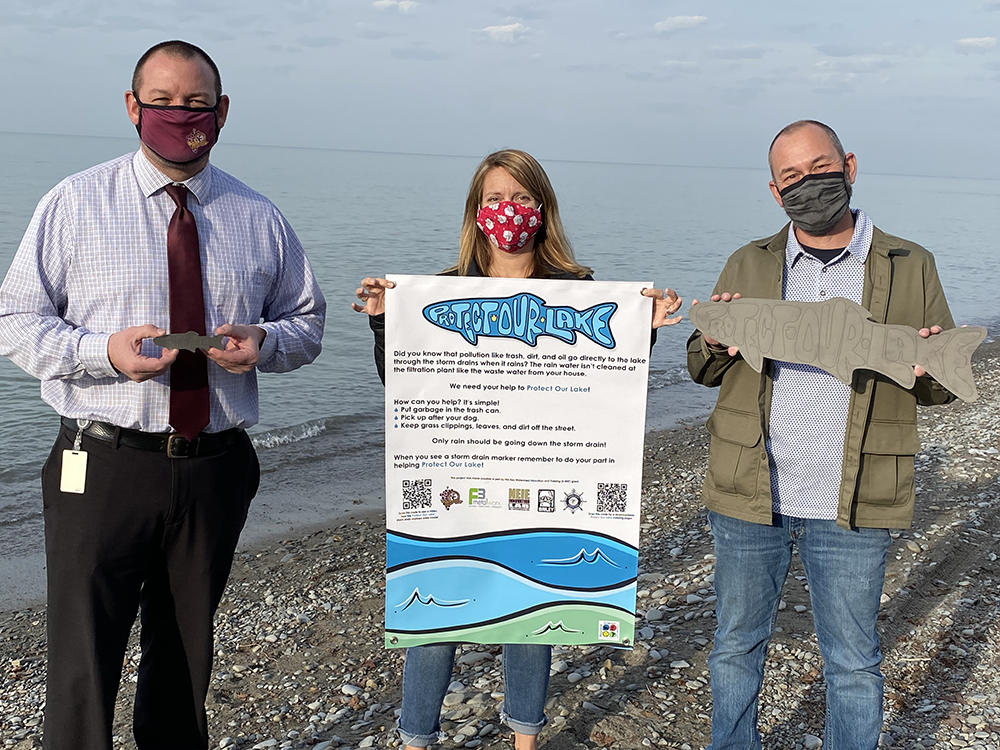
The goal of this project was to provide knowledge and expertise on action steps that can be considered and taken by all as a means to “Protect Our Lake” from trash, waste, and other harmful items that would negatively impact Pennsylvania’s valuable and accessible portion of the Great Lakes watershed. This project accomplished the following objectives: 1) Third grade enhanced their curriculum with new content on environmental issues plaguing the Great Lakes that instructors acquired from the Regional Science Consortium’s NOAA Bay Watershed Education & Training (B-WET) teacher trainings; 2) With guidance from their instructors, students developed a stewardship action project through an awareness campaign to their community by creating storm drain markers, reminding citizens that what goes down the drain most certainly travels to Lake Erie; 3) Storm drain markers were fabricated by a local metal fabrication company and installed on storm drains throughout the school district campus as well as our borough public park. One hundred-twenty third grade students used the learned information about the Great Lakes, and Lake Erie in particular, to take action and make a difference.